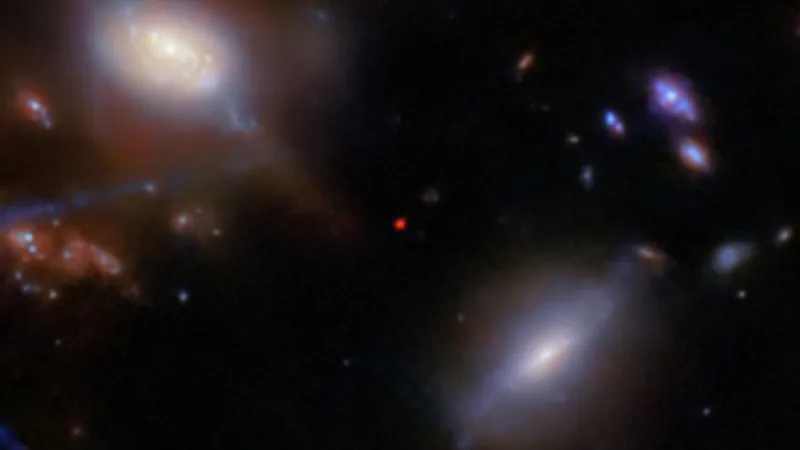
NASA’s Groundbreaking Discovery: First Cosmic Lights from the Dawn of the Universe!
2025-04-02
Author: Kai
NASA's Groundbreaking Discovery: First Cosmic Lights from the Dawn of the Universe!
NASA's James Webb Space Telescope (JWST) has made a monumental breakthrough in our understanding of the universe, capturing the first evidence of light shining through the cosmic veil, just 330 million years post-Big Bang. This remarkable discovery challenges existing theories about the early cosmos.
An international team of researchers utilized JWST to observe an ancient galaxy known as JADES-GS-z13-1-LA, which somehow emitted light despite being enveloped in a thick fog of neutral hydrogen gas that typically absorbs such emissions. This galaxy, one of the most distant ever detected, boasts light that traveled nearly 13.5 billion light-years to reach JWST, effectively making it nearly as ancient as the universe itself.
As astronomers peer deeper into the universe with advanced telescopes like the JWST, they effectively look back in time, inching closer to the moments that birthed our cosmos. The team discovered Lyman-alpha emission from JADES, a specific wavelength of light easily absorbed by neutral hydrogen. The detection of this emission implies that the fog surrounding the galaxy had dissipated, indicating that JADES was actively clearing the neutral hydrogen gas.
"This result was totally unexpected by theories of early galaxy formation and has caught astronomers by surprise," stated Roberto Maiolino, co-researcher and astrophysicist from the University of Cambridge and University College London. The universe began approximately 13.8 billion years ago, initially characterized by a dark and foggy expanse, devoid of stars or galaxies—a period known as the "dark ages."
This dark epoch persisted until about 680 million years after the Big Bang, when the first stars and galaxies began to form, emitting ultraviolet radiation that gradually broke apart the hydrogen atoms and rendered the universe more transparent to light. Within a billion years post-Big Bang, the cosmos transformed from an opaque sea into a sparkling universe.
Determined to uncover more about this enigmatic galaxy, researchers analyzed its characteristics and found that it dates back to the middle of the cosmic dark ages, a time when neutral hydrogen gas should have been dense enough to obscure any light emission. "We really shouldn't have found a galaxy like this, given our understanding of the way the universe has evolved," remarked Kevin Hainline, co-author and astronomer at the University of Arizona.
Despite the challenges of the dense hydrogen fog, the researchers detect a beam of light piercing through it, raising fundamental questions about the nature of cosmic evolution. "This fascinating emission line has huge ramifications for how and when the universe reionized," Hainline added.
Though the exact mechanisms behind the light emission remain unclear, the researchers speculate a few theories. One possibility is that JADES hosts extremely massive, hot stars that produce ionizing radiation more efficiently than average stars today. This could result in gas heating to temperatures exceeding 15 times hotter than the sun’s surface, yielding powerful radiation emissions.
Another intriguing theory posits the presence of an active supermassive black hole in JADES, where the radiation from material falling into the black hole ionizes nearby gas. Supporting this notion, measurements suggest JADES has an extremely compact size, typical of galaxies with black holes.
Regardless of the source, this groundbreaking capture provides a glimpse into the very first light from the universe's oldest stars and holds the potential to reshape our understanding of cosmic history. The research team's findings have been published in the esteemed journal *Nature*, paving the way for future exploration and unraveling the mysteries of our universe's early evolution. Get ready, because this discovery might just be the key to unlocking more secrets of the cosmos!


 Brasil (PT)
Brasil (PT)
 Canada (EN)
Canada (EN)
 Chile (ES)
Chile (ES)
 Česko (CS)
Česko (CS)
 대한민국 (KO)
대한민국 (KO)
 España (ES)
España (ES)
 France (FR)
France (FR)
 Hong Kong (EN)
Hong Kong (EN)
 Italia (IT)
Italia (IT)
 日本 (JA)
日本 (JA)
 Magyarország (HU)
Magyarország (HU)
 Norge (NO)
Norge (NO)
 Polska (PL)
Polska (PL)
 Schweiz (DE)
Schweiz (DE)
 Singapore (EN)
Singapore (EN)
 Sverige (SV)
Sverige (SV)
 Suomi (FI)
Suomi (FI)
 Türkiye (TR)
Türkiye (TR)
 الإمارات العربية المتحدة (AR)
الإمارات العربية المتحدة (AR)